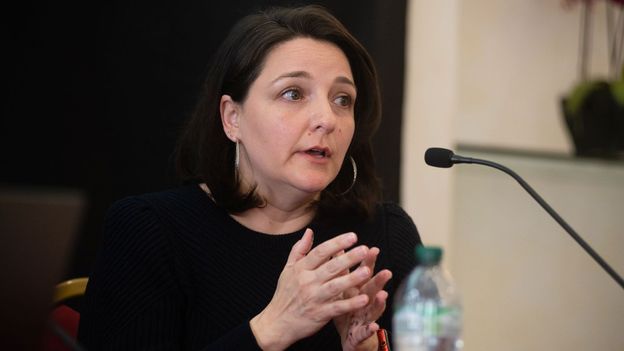   
CEO Picks - The best that international journalism has to offer!
 S70 S70 S2 S2Generative AI Will Change Your Business. Here's How to Adapt.   Generative AI can “generate” text, speech, images, music, video, and especially, code. When that capability is joined with a feed of someone’s own information, used to tailor the when, what, and how of an interaction, then the ease by which someone can get things done, and the broadening accessibility of software, goes up dramatically. The simple input question box that stands at the center of Google and now, of most Generative AI systems, such as in ChatGPT and Dall-e, will power more systems.
Continued here
|
 S3 S3What Does It Actually Take to Build a Data-Driven Culture?   Building a data driven culture is hard. To capture what it takes to succeed, the authors look at the first two years of a new data program at Kuwait’s Gulf Bank in which they worked to build a culture that embraced data, and offer a few lessons. First, it is important to start building the new culture from day one, even as doing so is not the primary mandate. Second, to change a culture, you need to get everyone involved. Third, give data quality strong consideration as the place to start. Finally, building this new culture takes courage and persistence.
Continued here
|
 S4 S4The Five Stages of Small-Business Growth   Categorizing the problems and growth patterns of small businesses in a systematic way that is useful to entrepreneurs seems at first glance a hopeless task. Small businesses vary widely in size and capacity for growth. They are characterized by independence of action, differing organizational structures, and varied management styles.
Continued here
|
 S5 S5The Questions Every Entrepreneur Must Answer   Diversify your product line. Stick to your knitting. Hire a professional manager. Watch fixed costs. Those are some of the suggestions that entrepreneurs sort through as they try to get their ventures off the ground. Why all the conflicting advice? Because in a young company, all decisions are up for grabs.
Continued here
|
 S6 S6Cope or Quit? Facing a Mid-Career Crisis   Research shows that many people—even those with seemingly enviable careers—grow dissatisfied in their jobs in their mid-40s. They may regret past choices or feel stuck in a rut. But Kieran Setiya thinks the tools of his trade—philosophy—can help. He says sadness about the road not taken can be mitigated by attending to the people and pursuits that we cherish and wouldn’t have without our careers. He notes that we spend much of our work time solving problems and meeting needs, so we should engage in some feel-good activities (inside or outside the office). And he suggests focusing less on projects and more on process, to replace a “What’s next?” mindset with an appreciation for the present.
Continued here
|
 S7 S7A New Model for Ethical Leadership   Rather than try to follow a set of simple rules (“Don’t lie.” “Don’t cheat.”), leaders and managers seeking to be more ethical should focus on creating the most value for society. This utilitarian view, Bazerman argues, blends philosophical thought with business school pragmatism and can inform a wide variety of managerial decisions in areas including hiring, negotiations, and even time management. Creating value requires that managers confront and overcome the cognitive barriers that prevent them from being as ethical as they would like to be. Just as we rely on System 1 (intuitive) and System 2 (deliberative) thinking, he says, we have parallel systems for ethical decision-making. He proposes strategies for engaging the deliberative one in order to make more-ethical choices. Managers who care about the value they create can influence others throughout the organization by means of the norms and decision-making environment they create.
Continued here
|
 S8 S8The Founder's Dilemma   The author’s studies indicate that a founder who gives up more equity to attract cofounders, new hires, and investors builds a more valuable company than one who parts with less equity. More often than not, however, those superior returns come from replacing the founder with a professional CEO more experienced with the needs of a growing company. This fundamental tension requires founders to make “rich” versus “king” trade-offs to maximize either their wealth or their control over the company.
Continued here
|
 S9 S9 The Role of Culture in Enabling Change   Our special report on innovation systems will help leaders guide teams that rely on virtual collaboration, explores the potential of new developments, and provides insights on how to manage customer-led innovation.Our special report on innovation systems will help leaders guide teams that rely on virtual collaboration, explores the potential of new developments, and provides insights on how to manage customer-led innovation.Culture is often described as “how we do things around here” — a passive reflection of legacy norms and behaviors. It’s more helpful to think of culture as the nervous system of an organization. In biology, the central nervous system is the pathway by which thoughts in our brains are translated into actions by our muscles, and how our experience of acting in the world updates our brain’s understanding of the world. In organizations, this means thinking of culture as the transmission mechanism by which a company both communicates its intended strategy to the front lines and receives feedback and intelligence from the field about whether the strategy is achieving the intended outcomes in the market.
Continued here
|
 S10 S10How Spanish fluency became a competitive business advantage   During her first couple years in the advertising industry, Dani Herrera says colleagues asked her questions like, "Should we schedule this meeting for later in the afternoon? I know you people like to take a little siesta after lunch" and "How come you speak English so well?"When Herrera moved from Argentina to New York City for work in her early 30s, she knew it would be a big adjustment – but she didn't expect to be on the receiving end of micro- and macro aggressions at work for her cultural and linguistic background.
Continued here
|
 S11 S11Digital nomads have billions to spend. Entrepreneurs are cashing in.   When Johannes Voelkner founded Nomad Cruise in 2015, his primary aim was to tackle loneliness. It was a problem he was well familiar with as a digital nomad; after five years on the road, he'd struggled always starting from scratch to meet people in new places.Nomad Cruise is the first mobile conference for digital nomads. It combines skill-sharing, networking and celebration while travelling through breathtaking corners of the globe. And German-born Voelkner, 40, says it's achieving his aim.
Continued here
|
 S12 S12Emmentaler: Switzerland's king of cheeses   Switzerland is a nation of cheese. With a population of just under nine million, it produces 207,000 tons a year – and of the more than 450 kinds of cheese produced, there's one that's known as the "king of cheese", a food so famous it has become synonymous with the country itself. That cheese, of course, is Emmentaler – or "Swiss cheese", as it's known in North America.It's hard not to overstate Emmentaler's ubiquity. Along with Swiss army knives, cuckoo clocks and cowbells, the cheese with holes is one of Switzerland's most immediately recognisable symbols. Souvenir shops sell Emmentaler-shaped key rings and Emmentaler-inspired socks. For six years, the speed suits of the Swiss ski team looked like Emmentaler, earning international attention at the 1994 Olympic Games. The cheese's international fame even starts in childhood: from the The Very Hungry Caterpillar book to the cartoon Peppa Pig, when there's cheese, it is yellow with holes.
Continued here
|
 S13 S13Mandy Yin's Sarawak white chicken   Deep in the jungles of Borneo in Sarawak, Malaysia's largest state, are small pockets of peppercorn farms. The bright green pepper vines that nestle on steep hills slanting down towards rivers and streams are vibrant against the deep green of the jungle. Cultivated mostly by Indigenous communities such as the Iban, these small, family-run farms grow some of the best pepper in the world.Mandy Yin, the owner of a renowned Malaysian restaurant in North London called Sambal Shiok, visited such a farm in 2019. It was here that she first tried manok pansoh, a traditional Iban dish. In the Iban language, pansoh means to "cook in green bamboo over open fire", and manok means "chicken". The dish is frequently cooked at celebratory times, especially at Gawai, the June harvest festival celebrated by Sarawak's Indigenous communities.
Continued here
|
 S14 S14Ken Loach's The Old Oak: How the 1984 miners' strike defined Britain today   Throughout his 60-year career, director Ken Loach has seen sweeping societal changes in Britain, from the reforms of the 1960s, the watershed 1984-5 miners' strike and the weakening of trade unions in the 1980s, to more recently, Brexit and the pandemic. Yet it was the 1984 strike that inspired the 87-year-old director to make what could be his final feature, The Old Oak. For Loach, the strike's outcome shaped the future of the country. "The miners' strike was the pivotal event," Loach tells BBC Culture.
Continued here
|
 S15 S15Marina Abramovic: Is she still the most dangerous woman in art?   At Studio Morra, Naples in 1974, for six hours, it was possible to be in the same room as Marina Abramović. Of course, the performance artist has occupied many rooms since, but this was the room – the most notorious one, the site of her work Rhythm 0, in which she stood completely still and invited the audience to do what they wanted to her using any of 72 items laid out for them."I am the object. During this period I take full responsibility," was the instruction. All her clothes were removed from her with razor blades, and a man forced her to press a loaded gun to her neck. The next morning a clump of the artist's hair had turned grey.
Continued here
|
 S16 S16What the new Assassin's Creed game tells us about ninth-century Baghdad - from the art historian who worked on the game   Gamers the world over will be familiar with the incredibly detailed historic cityscapes the Assassin’s Creed franchise has produced so far. Following earlier forays into ancient Damascus and Athens, the forthcoming instalment, Mirage, takes players into ninth-century Baghdad, the capital of the Abbasid caliphate.As an expert in Islamic architecture, art, and history, I worked with world design director Maxime Durand and Mirage historian Raphaël Weyland to bolster the game’s historical grounding, including the new educational feature, entitled The History of Baghdad. Gamers will be able to explore, in an interactive way, the economy, government, arts, beliefs and daily life of the time.
Continued here
|
 S17 S17 S18 S18 S19 S19 S20 S20 S21 S21Nationwide test of Wireless Emergency Alert system could test people's patience - or help rebuild public trust in the system   The Wireless Emergency Alert system is scheduled to have its third nationwide test on Oct. 4, 2023. The Wireless Emergency Alert system is a public safety system that allows authorities to alert people via their mobile devices of dangerous weather, missing children and other situations requiring public attention.Similar tests in 2018 and 2021 caused a degree of public confusion and resistance. In addition, there was confusion around the first test of the U.K. system in April 2023, and an outcry surrounding accidental alert messages such as those sent in Hawaii in January 2018 and in Florida in April 2023.
Continued here
|
 S22 S22 S23 S23Reagan wouldn't recognize Trump-style 'conservatism' - a look at how the GOP has changed   When Mitt Romney announced his intended retirement from the U.S. Senate on Sept. 13, 2023, the Atlantic published an excerpt from his upcoming biography, in which the 2012 Republican presidential nominee told author McKay Coppins, “A very large portion of my party really doesn’t believe in the Constitution.” This claim would have been startling 15 years ago. For decades, the Republican Party has been the party of conservatism and a champion for the Constitution.
Continued here
|
 S24 S24I'm working to revitalize an Indigenous language and bring it into the future   Language is foundational to Indigenous communities, including my own, and a vital connection to our cultures. It is well documented how residential schools in Canada and boarding schools in the U.S. devastated Indigenous languages and severed cultural connections. While our languages are in decline, efforts to sustain them are ongoing, and I am taking part in that work.
Continued here
|
 S25 S25Debating the 'success' of multiculturalism misses the point - it's simply part of life in Britain today   Suella Braverman – the home secretary in one of the UK’s most ethnically diverse cabinets in history – has declared that multiculturalism has failed. Speaking to an American think tank, Braverman spoke out against what she called a “misguided dogma” that has “allowed people to come to our society and live parallel lives in it”. I am a historian of multiculturalism, and grew up in Balsall Heath, an area of Birmingham with a decades-long history of rich cultural diversity. My experience of multiculturalism is not as something that can fail or succeed, but as something that shaped my life and that of my peers in a meaningful way. Comments like Braverman’s – and indeed, other politicians before her – ignore the reality of what multiculturalism means to people.
Continued here
|
 S26 S26 S27 S27 S28 S28 S29 S29 S30 S30 S31 S31Sycamore Gap: what the long life of a single tree can tell us about centuries of change   Only a few individual trees could be rightly labelled as world famous, but the tree at Sycamore Gap along Hadrian’s Wall in northern England was one of them. No wonder its recent felling provoked public outcry and collective mourning. The tree’s dramatic and photogenic setting made it a culturally significant landmark, often used as a symbol of the surrounding Northumberland region. However, this single tree also symbolised our relationship with the landscape in this part of the world, both past and future.
Continued here
|
 S32 S32Airlines are being hit by anti-greenwashing litigation - here's what makes them perfect targets   A wave of anti-“greenwashing” litigation is seeking to hold major players in the aviation industry to account for sensational claims of being sustainable, low-carbon or contributing to net zero. While the industry has faced legal backlash in the past, the dramatic proliferation of these cases may spell disaster for major airlines.It’s not hard to see why the aviation industry has provoked the ire of climate activists. Flying is responsible for a staggering 5% or so of human-induced global warming and its climate impact is still growing at a rate far greater than almost any other sector.
Continued here
|
 S33 S33 S34 S34Death of the Armenian dream in Nagorno-Karabakh was predictable but not inevitable   Thirty-five years ago, more than 100,000 Armenian protesters took to the streets to convince Soviet leader Mikhail Gorbachev that Nagorno-Karabakh – an ethnically Armenian enclave stuck geographically in the neighboring republic of Soviet Azerbaijan – ought to be joined to Armenia.In recent days, more than 100,000 people have taken to the streets again. But this time it is Karabakh Armenians fleeing their homes to find refuge in Armenia. They have been decisively defeated by the Azerbaijanis in a short and brutal military operation in the enclave. Their dream of independence appears over; what is left is the fallout.
Continued here
|
 S35 S35 S36 S36Microplastics in the mud: Finnish lake sediments help us get to the bottom of plastic pollution   The sun is shining, and air feels surprisingly warm when we walk on a 35cm ice that covers a frozen lake in central Finland. The heavy sledges move nicely, because there is not much snow on the ice today. The journey isn’t far either, as we’re by the city of Kuopio, which is surrounded by Finland’s 10th largest lake. Despite the temperature of -10˚, I need to take off my hat – the sun in early March is already warm, or it could be the fact that the heavy sledge is following me obediently.Lake Kallavesi has a specific and rare type of sediments called annually laminated or varved sediments. They’re composed of a bright and dark couplets one after the other, just like tree rings, that can be counted backwards. It is possible to check how your birth year looked – or your grandmother’s birth year. Such sediment layers can reach back thousands of years.
Continued here
|
 S37 S37Suella Braverman warns of 'unmanageable' numbers of asylum seekers - the data shows we hardly take any   A migration “hurricane” is coming, Suella Braverman has warned. Speaking at the Conservative party conference, the home secretary claimed that without action by the Conservatives, millions more people will come to Britain, “uncontrolled and unmanageable”. The idea that there is a “right” amount of migration has a long history in Britain, despite not being very helpful as a metric. But let’s play along, as it’s clear that migration and asylum – largely discussed in terms of numbers of small boat arrivals – will be a major campaigning focus ahead of the next election.
Continued here
|
 S38 S38What does it mean to be a 'daddy'?   The term “daddy” has exploded in popularity in recent years. Actor Pedro Pascal was recently crowned the internet’s daddy. There is an app called Dream Daddy where players can date a daddy. Saturday Night Live even ran a skit about daddies. My new book, Daddies of a Different Kind: Sex and Romance Between Older and Younger Adult Gay Men, investigates this topic. I talked to 39 men in their 40s, 50s and 60s who saw themselves as daddies, and 26 men in their 20s and 30s who liked dating older men. I focused on gay and bisexual men because they are more likely to form partnerships with large age gaps than any other group in the western world.
Continued here
|
 S39 S39Female animals teach each other to choose unusual males - new research   My friend recently changed their favourite celebrity crush from Anna Kendrick toLily James. While some people could see the attraction, others mightnot. So, what is it that attracts us to potential mates? A new study suggests that female animals learn from other females to prefer distinctive males as mates.Sexual selection involves the evolution of traits such as the long, elaborate tailof the peacock. These traits have evolved to enhance an animal’s chance of attracting a mate, rather than to enhance survival ability. A weighty, colourful tail is a hindrance if you’re trying to evade a predator.
Continued here
|
 S40 S40
 |
TradeBriefs Publications are read by over 10,00,000 Industry Executives About Us | Advertise Privacy Policy Unsubscribe (one-click) You are receiving this mail because of your subscription with TradeBriefs.
Our mailing address is GF 25/39, West Patel Nagar, New Delhi 110008, India |




















































































/https://tf-cmsv2-smithsonianmag-media.s3.amazonaws.com/filer_public/71/3d/713d0cb9-6d93-4e0e-8376-8ed3abf1245e/ywp_lemurjpg.jpg)






































